Family : Muscicapidae

Text © Dr. Gianfranco Colombo

English translation by Mario Beltramini
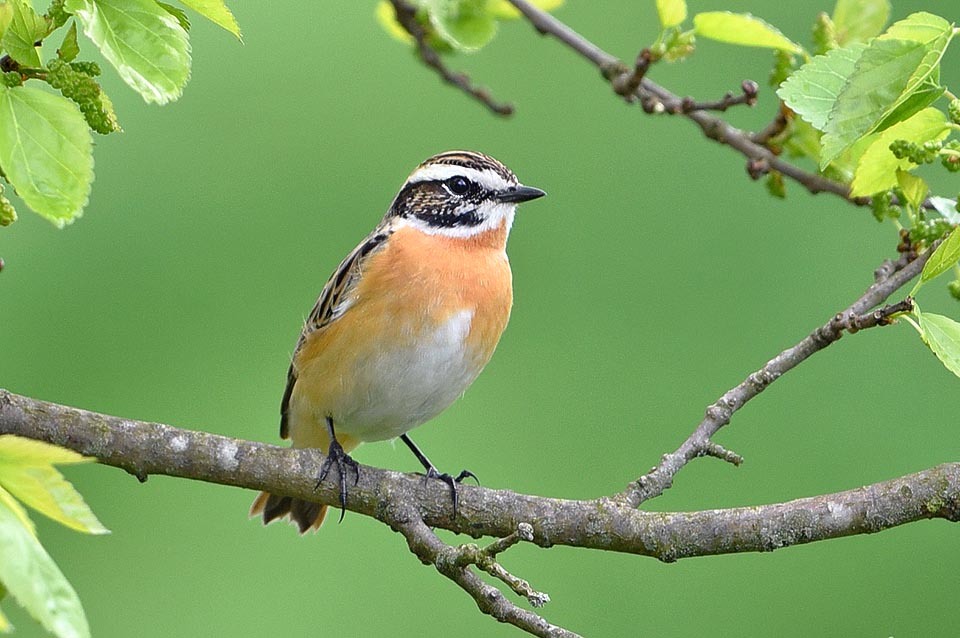
The Whinchat (Saxicola rubetra) is a very coloured bird, territorial and shy but that draws the attention perching on the smallest reliefs of the ground or the few shrubs present in the barren land where it lives. The male has a showy nuptial livery with orange chest up to the belly that keeps always whitish © Gianfranco Colombo
The fact that nature has at times poorly comprehensible behaviours for us humans, is an established and of common knowledge fact. Our innate hurry to want to understand in a short time problems that nature has solved in hundreds of thousands of years, pushes us at times to give a justification that satisfies more our curiosity than the reality of facts, making us forget that behind all stand indisputable and unappealable leading threads, plausible and natural, called evolution and evolutionary convergence. Different species sharing the same habitat evolve and develop similar behaviours and adaptations.
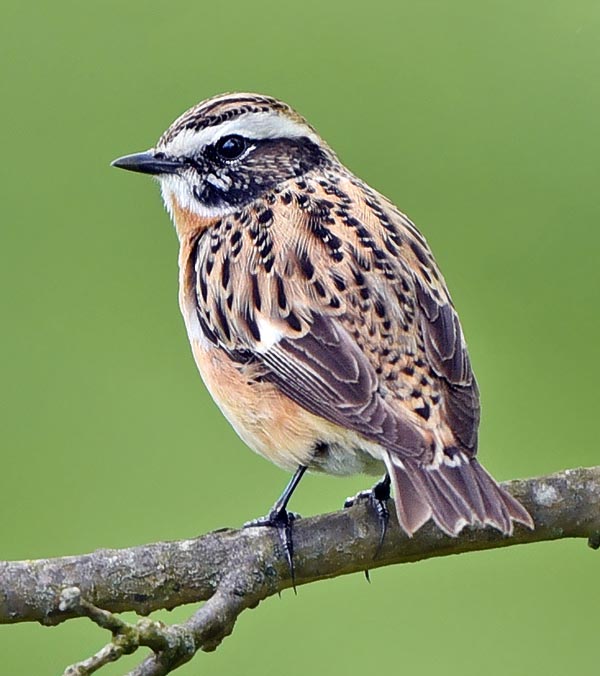
Seen from the back. Characteristic is the white eyebrow present in both sexes © Gianfranco Colombo
Actually, it would be otherwise difficult to understand the reason why two species of birds belonging to the same genus, so much similar to be confused, with coinciding feeding habits and living in the same territory during the nesting, such as the Black redstart (Phoenicurus ochruros) and the very similar Common redstart (Phoenicurus phoenicurus), in winter one decides to move a little and the other to embark on a journey of thousands of km and penetrate dangerous and remote tropical areas.
In this way as well the Grey wagtail (Motacilla cinerea) and the Western yellow wagtail (Motacilla flava) practically similar, same genus, same feeding, same territory and different winter destination.
And also the Lesser grey shrike (Lanius minor) and the Northern shrike (Lanius excubitor) and also the Common stonechat (Saxicola torquatus) and the whinchat here described.
The Whinchat (Saxicola rubetra Linnaeus, 1758) belongs to the order of the Passeriformes and to the family of the Muscicapidae, although previously placed in the Turdidae and is in the Palearctic practically the summer double of the common stonechat.
A nice and minute very coloured small bird, very territorial and very shy but who is able to draw the attention staying on the smallest reliefs of the soil or the few shrubs present in the barren territory it loves to frequent.
Quite similar to the common stonechat in the behaviour, with whom it can be easily mistaken, in particular during the spring migration, when fully shares the territory, it can be seen hunting insects with actions very similar to its congener. From the roost where it stays, here it is, suddenly jumping to the ground and after a short run, catching rapidly an insect or a caterpillar hidden into the grass and then going back on top to devour the prey.
Unlike the first who has a very aerial hunting modality, the whinchat is more terricolous and uses the roost only for observing the surrounding ground and then gets down to the soil and stays there even for some moments.
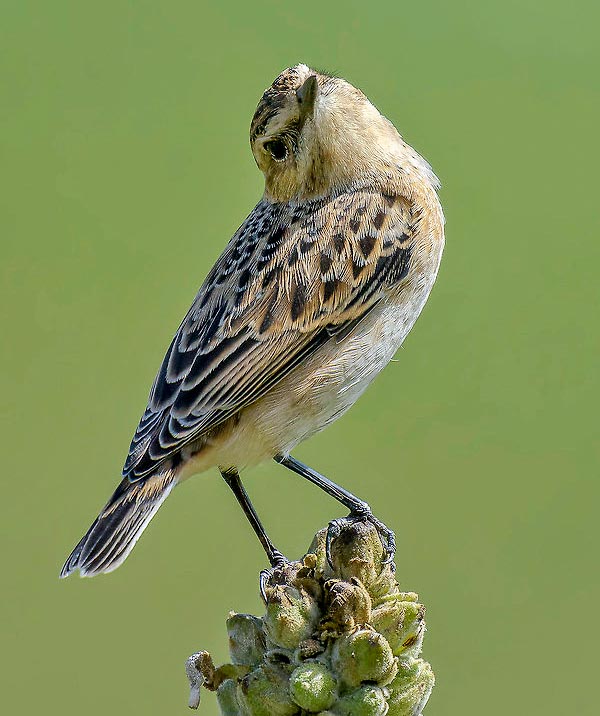
The female, decidedly more modest in colours, is a pale copy of the male in nuptial livery. It distinguishes however in any season for the absence of the intense black on the facial mask © Antino Cervigni
At times it rummages and totters in the low grass, hopping on the clods and on the stones scattered on the ground, stopping then to rest but staying well erect and strutting on a few cm tall small stone. In this position it passes almost unnoticed as its colour blends perfectly with the surrounding ground.
The etymology of the scientific name of the genus Saxicola gets origin from the union of two Latin terms “saxus” = stone and “cola” from “colere” = to live, rightly due to the customary habitat frequented by the species; rubetra comes always from the Latin “rubus” = bramble but also with a direct reference to Aristotle who talked, indicating it with this name, of a similar bird that nourished of caterpillars collected on the ground.
As usual the Italian fantasy in giving particular names, at times even not strictly referable to the nominated subject and derived from common sayings and dialectal jargons or from unpronounceable misspellings, has given its fruits also with the whinchat. The Tuscans in this case appear having invented the Italian name “stiaccino”, deriving it form their way of pronouncing the verb “schiacciare” (to crush) = “stiacciare”, taking the behaviour that this small bird keeps when on the ground when it seems to hide behind any corrugation. Brits instead think on the contrary calling it Whinchat referring to the plant of the Gorse or Common gorse (Ulex europaeus) also called “whin”, where this bird loves to usually perch. Always in Europe, it is called in German Braunkehlchen, in Spanish Tarabilla Norteña, in French Tarier des prés, in Portuguese Cartaxo-nortenho, in Italian Stiaccino and to finish in Japanese a nice Mamijironobitaki.
Zoogeography
The whinchat occupies almost totally the European continent, the Caucasian area and the western Asian Siberian part. In Europe it is amply diffused in the central eastern part, as well as in the northern part, in the whole European Russia, with attenuation of the presence while going to the Mediterranean part.
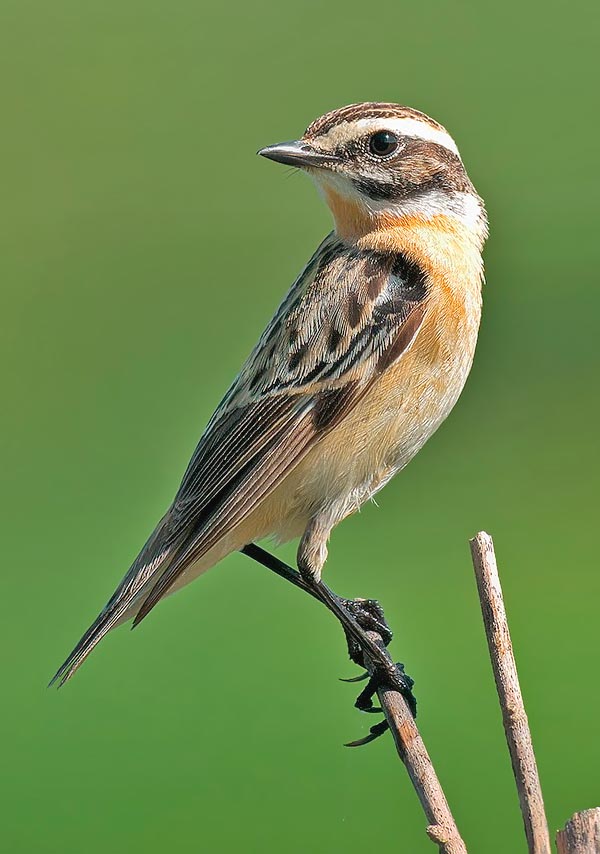
It occupies almost all the European continent, the Caucasian area and the Asian part of western Siberia © Antino Cervigni
It occupies all the Pyrenean area but decreases its presence in the Iberian Peninsula where it is poorly localized and is even missing in the central southern part.
It is also absent in Greece and in Iceland, whilst in Italy it is well diffused on the Alps, whilst on the Apennines has areas completely left empty and its presence gets increasingly sparse going southwards.
It is absent in the main islands.
The whinchat is a long range migrant that winters in Africa in the sub-Saharan area from Senegal to Ethiopia, covering in the estern part all the Rift Valley up to Tanzania.
The species is monotypic therefore no subspecies have been classified even if are under evaluation some particularities found in some populations.
Ecology-Habitat
As previously said the whinchat occupies hilly and mountainous habitats in rather bleak and poorly treed landscapes, with little vegetation formed by small shrubs or even of only grassy essences especially in the southern part of the range whilst in the north of the territory is present also in plains having similar characteristics.
On the Italian mountain ranges it settles up to 2000 m of altitude usually choosing facing south slopes as typical of the species belonging to its genus.
In the extreme north it frequents in fact also moors at the edge of the tundra, humid and also marshy meadows, a little deep grassy turf or with heather and at times completely barren and stony.
Unlike the stonechat it is rather solitary also in the habitats, usually choosing hilly prairies subject only to the summer pasture of animals or to a unique or occasional seasonal mowing.
These situations render the location particularly rich of insects they nourish of and rather healthy seen that they do not suffer from the ills of an indiscriminate use of herbicides and insecticides.
During the wintering in Africa, it occupies sites of any type but always poorly treed and arid. It does not disdain stony areas, areas at the edge of swamps, prairies close to the savannahs and mountain meadows.
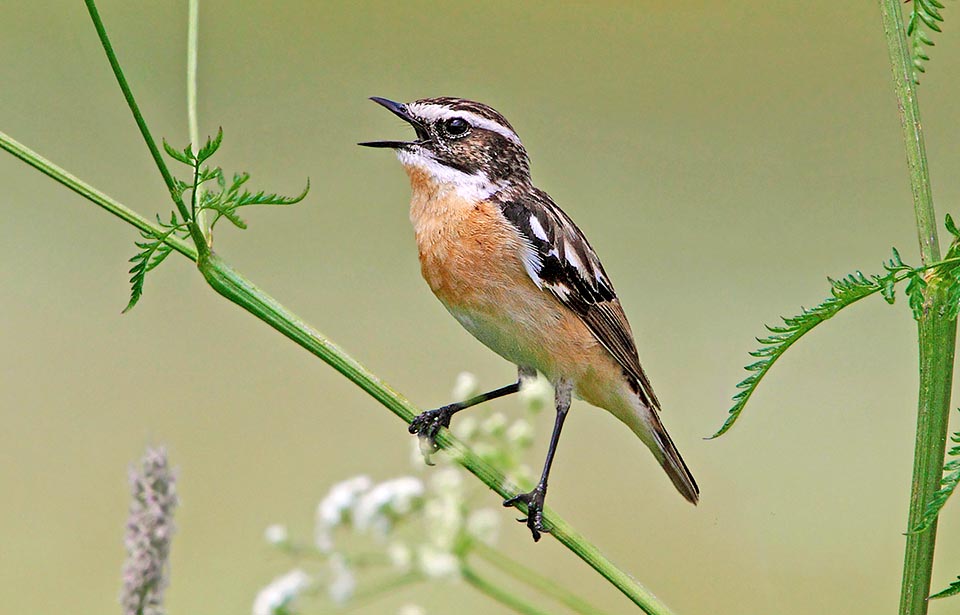
A male, just back from Africa for reproducting, claims singing its hunting territory © Luigi Sebastiani
Morphophysiology
The whinchat is an elegant small bird and with a silhouette slightly more slender than the stonechat although having an even shorter tail than its congener.
It has also a more horizontal posture when perched which consequently renders its figure more slender and less stocky if compared to that of the stonechat that is practically vertical in its posture.
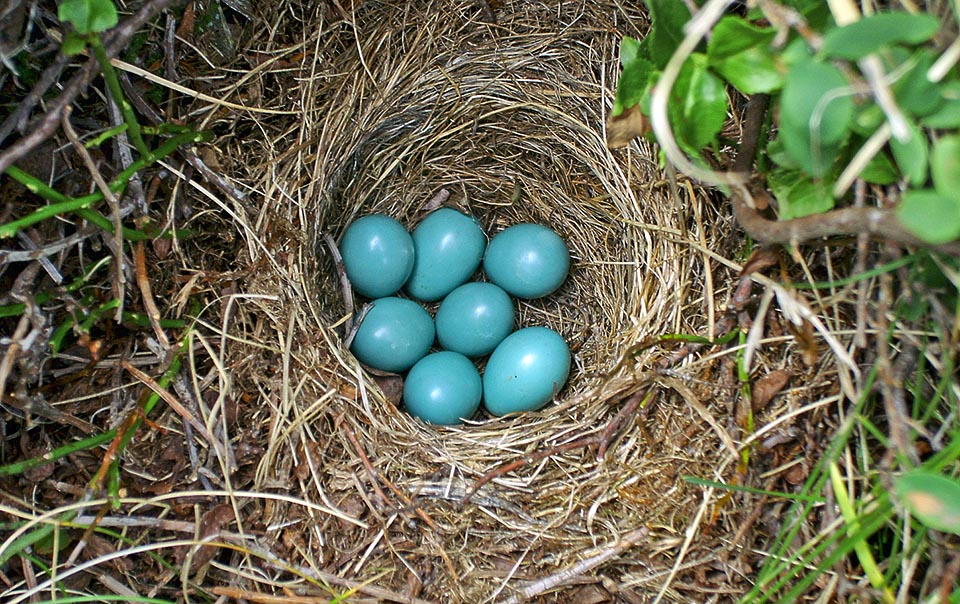
The nest, well hidden by the vegetation, is always done on the soil with moss, dry grass and rootlets. It contains 5-7 eggs brooded only by the female © Museo Civico di Lentate su Seveso
But these particularities are not by sure the only ones or sufficient for distinguishing this bird from similar species.
From the whinchat it mainly distinguishes and at first sight by the white eyebrow, well visible also from far away and always present in every seasonal livery of the male as well as of the female. Without this immediate reference it could be easily mistaken with the congener as the reddish colours and some black shades are present in both species.
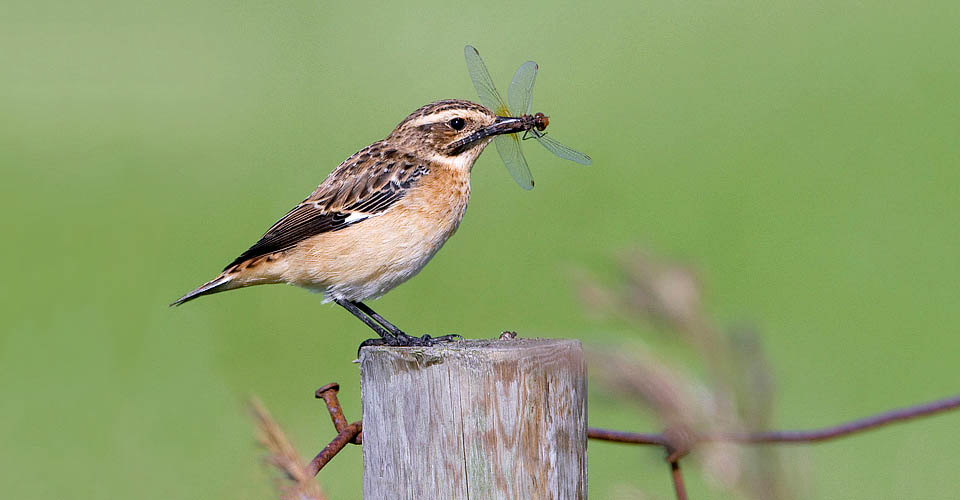
The whinchat is mainly insectivorous, especially while nesting, when big preys like this mean a precious protein input © Arie Ouwerkerk
The male whinchat has a nuptial livery well marked in the colours and displays the orange chest almost up to the belly that is always whitish, the head with an accentuated black mask limited in the upper part by a very neat white eyebrow that continues up to the nape resumed by a well distinct and white as well malar line.
The head is grey streaked with ochre, with a pattern that recurs and continues up to the covert. Brown tail and remiges with feathers fringed of ochre.

In autumn it integrates the diet with seeds and berries to gain weight and store the energy necessary to migrate southwards © Gianfranco Colombo
The female is fairly similar to the male apart the absence of the intense black on the facial mask and of the colours vividness. In the winter livery the male fades significantly in the shades and becomes much similar to the partner. The just fledged young have a quite insignificant livery, a brown plumage dotted with blackish spots on the chest that then accentuate during the plumage of the early winter.
It is 12 cm long, weighs 18 g and has a good wingspan of 25 cm characteristic of a strongly migrant species.
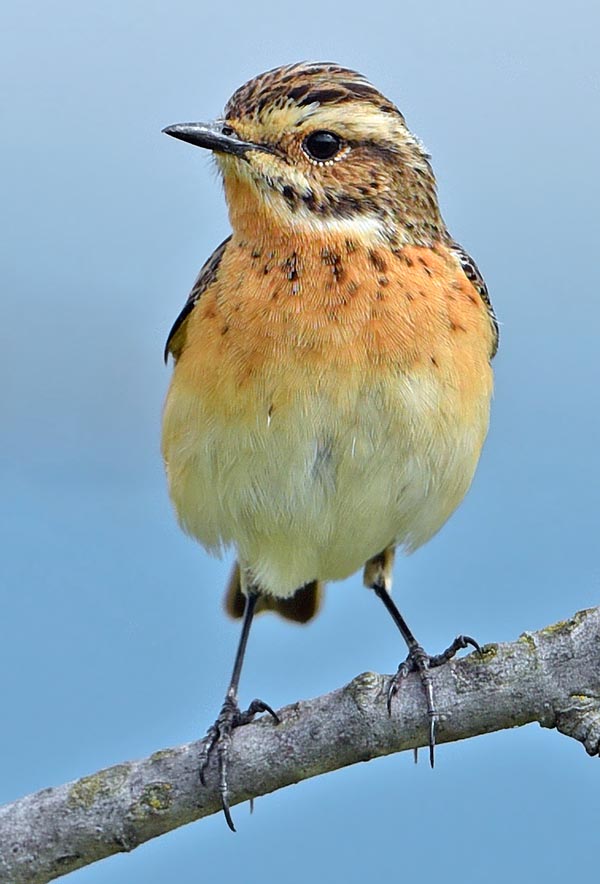
Here it is, ready for return, in full shape after the moult that precedes the migration © G. Colombo
Ethology-Reproductive Biology
Very terricolous species that for hunting uses also the ambush from a small relief that may be a shrub, a rock or even a dried up stem of a weed and from this roost it throws itself to the ground invariably hitting the victim.
It uses it also for doing those short flight, rapid and very fast, often vertical to seize in flight a small butterfly or an unwary dipteran.
The whinchat is mainly insectivorous for most of the year especially during the nesting but in autumn often integrates the feeding with berries and seeds probably for storing at the maximum the necessary energies necessary for the very long migration.
It nourishes of caterpillars, spiders and larvae but also of chrysalises of insects and small snails it catches continuously during the day with very few moments of respite.
As mentioned before, the choice range for the nesting is typically subalpine and formed by pasture meadows with the turf spaces by rocky outcrops and low shrubs.
The nest is always built on the ground, in a slight depression or on the crest of a slight ripple, immersed into the vegetation and covered by the same to firm a protecting cover that hides it completely from view.
The female digs a slight depression and fills it up with moss, dry grass and small rootlets to form a wide cup not too deep where are laid 5 to 7 eggs of a nice light blue colour at times finely and slightly dotted of reddish.
The brood, done only by the female, lasts a couple of weeks and the chicks stay in the nest for 17-18 days more even if they depend on the parents for some time more after their first flight. Usually, two broods are done per year.
Very solitary bird during the reproductive phase, turns instead very social by the time of the spring return to the nesting areas.
During the days of full migratory movement, we can observe at the foot of the mountain reliefs, groups of many tens of individuals perched in cluster on bushes or on fences or electrical cables, waiting for the doing the last leap that will take them on the nesting places.
Sometimes this wait extends for various weeks giving the illusion that the presence of this bird, in an unusual area for nesting, is premonitory of its anomalous reproduction in loco.
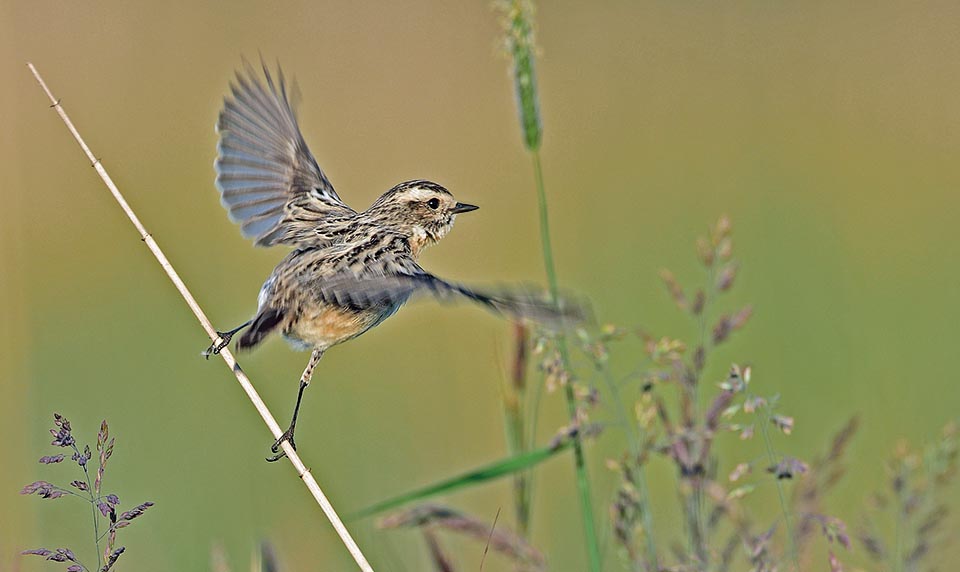
Taking off female. We note the tail, shorter than that of the stonechat, and a huge wingspan, typical of strong migrants: about 25 cm for a small bird weighing just 18 g © Wlodek Smardz
The advancement of the season in the lowland areas, does not coincide with the mountain climatic situation ans the small whinchat knows instinctively it must wait for the complete melting of the snowpack in its birth places, for being able to start a new reproductive season.
Synonyms
Motacilla rubetra Linnaeus, 1758.
→ To appreciate the biodiversity within PASSERIFORMES please click here.
